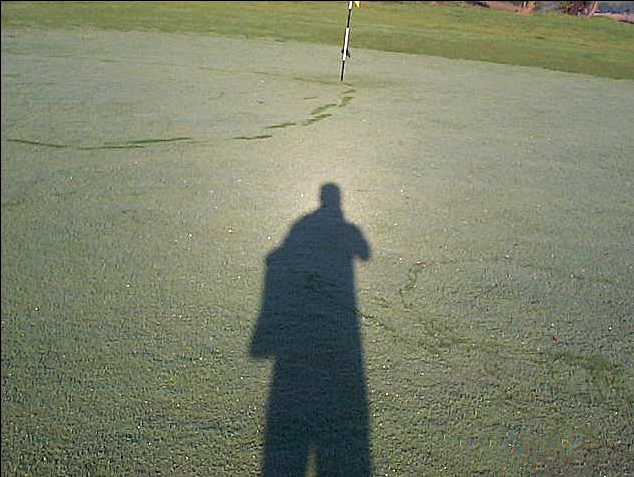Today's Feature - Heiligenschein
Today's Feature: Heiligenschein - Exploring the Holy Light Phenomenon
When it comes to optical effects in the atmosphere, the antisolar point, directly opposite the sun, is a treasure trove of captivating phenomena. It serves as the epicenter for a myriad of atmospheric wonders, including the tip of shadows, the mesmerizing multi-ringed glory, the origin of rainbows and fogbows, the convergence of ice halos, the hiding place of the elusive gegenschein, and the birthplace of the ethereal heiligenschein.
A heiligenschein, also known as the "holy light," manifests as a soft, radiant glow encircling the antisolar point. This enchanting phenomenon occurs when droplets on a morning dew-wet lawn bring sunlight into a rough focus on leaves or other surfaces. As a result, a portion of this concentrated light scatters backwards through the droplet towards the observer, creating a luminous and speckled glow centered on the eye.
It's important to note that each individual possesses their own personal heiligenschein, which is always centered on their head. Stand with a friend, and you will each have your own unique halo of light surrounding you. This is because the heiligenschein is a subjective experience, dependent on the position of the observer and their relationship to the sunlight interacting with dew-drenched surfaces.
To delve deeper into this captivating phenomenon, let's explore some fascinating aspects of heiligenschein:
1. The Science Behind Heiligenschein
Heiligenschein occurs due to a combination of two optical effects: the shadow-hiding effect and the Mie scattering effect. The shadow-hiding effect happens when light is refracted by droplets on a surface and focused onto a small region behind each droplet. On the other hand, Mie scattering is responsible for scattering light in all directions, including back towards the observer.
2. The Role of Droplet Size and Distribution
The size and distribution of the droplets on the surface play a crucial role in the appearance of heiligenschein. Smaller droplets tend to produce a more pronounced and vibrant halo, while larger droplets may create a softer and less defined glow. Additionally, the distribution of the droplets affects the overall appearance, with a denser distribution leading to a more prominent heiligenschein.
3. Heiligenschein and the Antisolar Point
The antisolar point serves as the focal point for heiligenschein. As the observer moves, the position of the antisolar point changes, resulting in a shifting heiligenschein. This dynamic nature adds to the allure and intrigue of this atmospheric phenomenon.
4. Other Factors Influencing Heiligenschein
While dew on leaves is a common scenario for heiligenschein formation, other surfaces can also contribute to its occurrence. Surfaces with irregularities or rough textures, such as grass, moss, or even sand, can produce captivating heiligenschein effects. Furthermore, atmospheric conditions, such as humidity and the angle of sunlight, can influence the intensity and visibility of the halo.
5. Heiligenschein in Photography
Heiligenschein presents a captivating opportunity for photographers to capture ethereal and enchanting images. By positioning themselves strategically and using the right lighting conditions, photographers can create stunning compositions featuring this elusive atmospheric phenomenon.
6. Heiligenschein in Cultural Beliefs
Throughout history, heiligenschein has been associated with various cultural beliefs and interpretations. In some cultures, it is considered a sign of divine presence or spiritual significance. Its ethereal nature and connection to light have inspired artists, poets, and mystics alike.
In conclusion, heiligenschein is a mesmerizing atmospheric phenomenon that adds an enchanting touch to our surroundings. Its manifestation around the antisolar point, created by the interaction of sunlight with dew-laden surfaces, creates a soft, radiant glow that is unique to each observer. Exploring the science, factors influencing its appearance, and its cultural significance enhances our appreciation for this elusive and captivating holy light. So next time you find yourself surrounded by morning dew, take a moment to observe the heiligenschein and let its ethereal beauty transport you to a realm of wonder and awe.

Heiligenschein, Holy Light
Imaged by Kevin Boyle.
The antisolar point, the point directly opposite the sun, is a favoured spot for optical effects. It is the tip of shadows, the centre of the multi-ringed glory, the pivot of rainbows and fogbows, the crossing of many ice halos, the haunt of the elusive gegenschein and the locale of the soft glow made by hidden shadows.
This glow around the antisolar point, and photographer's camera and head, is a "heiligenschein". It is produced when droplets on a morning dew-wet lawn bring sunlight to a rough focus on leaves or other surfaces. Some of the concentrated light is then scattered backwards through the drop towards the viewer. The result, a bright speckled glow centered on the eye, or in this case the camera lens.
A heiligenschein is always centered on your head, it is your own heiligenschein. Stand with a friend and they will not be so illuminated. They, of course, will see and think otherwise because they will have their own personal heiligenschein.
Image ©Kevin Boyle, shown with permission.
Note: this article has been automatically converted from the old site and may not appear as intended. You can find the original article here.
Reference Atmospheric Optics
If you use any of the definitions, information, or data presented on Atmospheric Optics, please copy the link or reference below to properly credit us as the reference source. Thank you!
-
<a href="https://atoptics.co.uk/blog/todays-feature-heiligenschein/">Today's Feature - Heiligenschein </a>
-
"Today's Feature - Heiligenschein ". Atmospheric Optics. Accessed on November 26, 2024. https://atoptics.co.uk/blog/todays-feature-heiligenschein/.
-
"Today's Feature - Heiligenschein ". Atmospheric Optics, https://atoptics.co.uk/blog/todays-feature-heiligenschein/. Accessed 26 November, 2024
-
Today's Feature - Heiligenschein . Atmospheric Optics. Retrieved from https://atoptics.co.uk/blog/todays-feature-heiligenschein/.